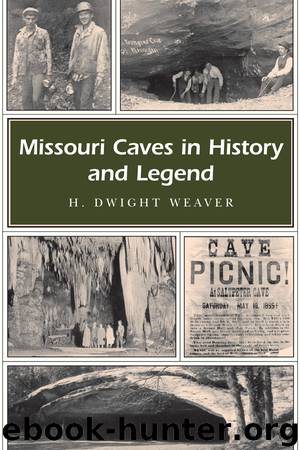Missouri Caves in History and Legend by H. Dwight Weaver

Author:H. Dwight Weaver
Language: eng
Format: epub
ISBN: 9780826266453
Publisher: University of Missouri Press
The crowd that attended this first event at Saltpeter Cave found that the cave had a spacious entrance passage, and three hundred feet inside, it opened into an immense, circular chamber that had a hard-packed, smooth clay floor. There were even two wings to the ballroom that were also large chambers. The temperature of the cave was a pleasant sixty degrees, and there was almost no dripping water. Most of the entrance corridor and ballroom was pleasantly dry.
Besides the dance floors Gideon and Schmuke had constructed, they had secured lanterns about the walls and along the entrance corridor, built a bar in the cave, a platform for the musicians, cleared brush from the area outside the cave, tidied up the riverfront, and put the old wagon road down to the cave in passable shape.
The event was so successful that Gideon and Schmuke planned additional weekend parties. Word spread quickly up and down the Frisco line, and people from both St. Louis and Springfield began to attend the events. Hardly a summer weekend passed without some type of sponsored activity at the cave. Gideon and Schmuke prospered so well that they continued to sponsor summer dances and picnics at Saltpeter Cave until 1910.
Saltpeter Cave, known today as Meramec Caverns, was not the only cave where cave parties were held. Green’s Cave and Fisher Cave, upstream from Saltpeter Cave, were also party sites. The Sullivan family of Sullivan, and the Schwarzer and Bienke families of Washington, Missouri, sponsored activities at Fisher Cave. “Cave parties are numerous these days,” the Sullivan Sentinel reported in July 1901.
Occasionally the crowds were so large special arrangements were necessary. An event at Green’s Cave in July 1903 was typical. Sixty people from St. Louis were involved. In October 1905 an even larger event was staged at Fisher Cave and entertained so many people the local paper declined to list them all by name but reported that, at the height of the party, “people attending came from Gray Summit, St. Louis, Kansas City and Pacific. . . . The party lasted for three or four days and employed three colored cooks.”
The Franz Schwarzer family of Washington organized a “cave explorers club” to engage in spelunking and partying at numerous caves along the Meramec. S. H. Sullivan Jr. of Sullivan also organized a caving club. They were the first organized caving clubs in Missouri but were certainly not like the caving clubs we have today.
From 1885 to 1925, caves throughout the Ozarks witnessed the new phenomenon—a craze for cave picnics and parties. Electricity had arrived in the cities, but most homes and businesses did not yet have air-conditioning. Caves were an ideal setting for cool summertime fun.
In the late nineteenth and early twentieth centuries, the United States had an expanding middle class in urban centers that demanded leisure pursuits and were willing to pay for them. People turned to the outdoors for all kinds of recreational activities because it was also the age of America’s first fitness and health craze.
Download
This site does not store any files on its server. We only index and link to content provided by other sites. Please contact the content providers to delete copyright contents if any and email us, we'll remove relevant links or contents immediately.
Man-made Catastrophes and Risk Information Concealment by Dmitry Chernov & Didier Sornette(5921)
The Revenge of Geography: What the Map Tells Us About Coming Conflicts and the Battle Against Fate by Kaplan Robert D(4035)
Zero Waste Home by Bea Johnson(3777)
COSMOS by Carl Sagan(3554)
Good by S. Walden(3487)
In a Sunburned Country by Bill Bryson(3481)
The Fate of Rome: Climate, Disease, and the End of an Empire (The Princeton History of the Ancient World) by Kyle Harper(3003)
A Wilder Time by William E. Glassley(2818)
Camino Island by John Grisham(2762)
The Ogre by Doug Scott(2631)
Organic Mushroom Farming and Mycoremediation by Tradd Cotter(2626)
Human Dynamics Research in Smart and Connected Communities by Shih-Lung Shaw & Daniel Sui(2466)
Energy Myths and Realities by Vaclav Smil(2438)
The Traveler's Gift by Andy Andrews(2409)
9781803241661-PYTHON FOR ARCGIS PRO by Unknown(2323)
Inside the Middle East by Avi Melamed(2305)
Birds of New Guinea by Pratt Thane K.; Beehler Bruce M.; Anderton John C(2224)
A History of Warfare by John Keegan(2186)
And the Band Played On by Randy Shilts(2129)
